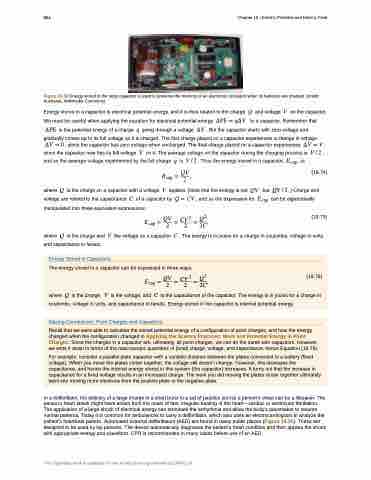Page 876 - College Physics For AP Courses
P. 876
864 Chapter 19 | Electric Potential and Electric Field
Figure 19.30 Energy stored in the large capacitor is used to preserve the memory of an electronic calculator when its batteries are charged. (credit: Kucharek, Wikimedia Commons)
Energy stored in a capacitor is electrical potential energy, and it is thus related to the charge � and voltage � on the capacitor. We must be careful when applying the equation for electrical potential energy ��� � ��� to a capacitor. Remember that
��� is the potential energy of a charge � going through a voltage �� . But the capacitor starts with zero voltage and gradually comes up to its full voltage as it is charged. The first charge placed on a capacitor experiences a change in voltage
�� � � , since the capacitor has zero voltage when uncharged. The final charge placed on a capacitor experiences �� � � , since the capacitor now has its full voltage � on it. The average voltage on the capacitor during the charging process is � � � , and so the average voltage experienced by the full charge � is � � � . Thus the energy stored in a capacitor, ���� , is
���� � ��� (19.74) �
where � is the charge on a capacitor with a voltage � applied. (Note that the energy is not �� , but �� � � .) Charge and voltage are related to the capacitance � of a capacitor by � � �� , and so the expression for ���� can be algebraically manipulated into three equivalent expressions:
���� � �� � ��� � ��� (19.75) � � ��
where � is the charge and � the voltage on a capacitor � . The energy is in joules for a charge in coulombs, voltage in volts, and capacitance in farads.
Energy Stored in Capacitors
The energy stored in a capacitor can be expressed in three ways:
���� � �� � ��� � ��� (19.76)
� � ��
where � is the charge, � is the voltage, and � is the capacitance of the capacitor. The energy is in joules for a charge in coulombs, voltage in volts, and capacitance in farads. Energy stored in the capacitor is internal potential energy.
Making Connections: Point Charges and Capacitors
Recall that we were able to calculate the stored potential energy of a configuration of point charges, and how the energy changed when the configuration changed in Applying the Science Practices: Work and Potential Energy in Point Charges. Since the charges in a capacitor are, ultimately, all point charges, we can do the same with capacitors. However, we write it down in terms of the macroscopic quantities of (total) charge, voltage, and capacitance; hence Equation (19.76).
For example, consider a parallel plate capacitor with a variable distance between the plates connected to a battery (fixed voltage). When you move the plates closer together, the voltage still doesn’t change. However, this increases the capacitance, and hence the internal energy stored in this system (the capacitor) increases. It turns out that the increase in capacitance for a fixed voltage results in an increased charge. The work you did moving the plates closer together ultimately went into moving more electrons from the positive plate to the negative plate.
In a defibrillator, the delivery of a large charge in a short burst to a set of paddles across a person’s chest can be a lifesaver. The person’s heart attack might have arisen from the onset of fast, irregular beating of the heart—cardiac or ventricular fibrillation. The application of a large shock of electrical energy can terminate the arrhythmia and allow the body’s pacemaker to resume normal patterns. Today it is common for ambulances to carry a defibrillator, which also uses an electrocardiogram to analyze the patient’s heartbeat pattern. Automated external defibrillators (AED) are found in many public places (Figure 19.31). These are designed to be used by lay persons. The device automatically diagnoses the patient’s heart condition and then applies the shock with appropriate energy and waveform. CPR is recommended in many cases before use of an AED.
This OpenStax book is available for free at http://cnx.org/content/col11844/1.14


